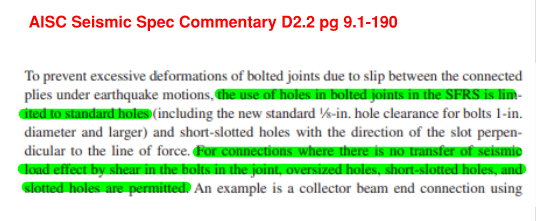I am currently in the process of reviewing shop drawings for a very large warehouse type structure. The structure was designed in accordance with IBC 2015/AISC 14th edition. I located the LFRS (lateral force resisting system) around the perimeter of the building utilizing a concentric brace frame.
At the perimeter steel, the fabrication is calling for short slots in all of the beam to column connections. I would like to avoid this type of hole in these elements as these beams are acting as collectors for the brace frame system. Out of interest, I went digging into the AISC and they seem to allow for short slotted holes at the discretion of the EOR. The commentary has some discussion about why short slots are allows.... and shocker, it has to do with allowing for proper plumbing of the columns.
In this instance, where the perimeter beams are acting as a collector for the LFRS what are others doing? Are you allowing for short slots to be used in this instance? or do you insist on STD holes?
At the perimeter steel, the fabrication is calling for short slots in all of the beam to column connections. I would like to avoid this type of hole in these elements as these beams are acting as collectors for the brace frame system. Out of interest, I went digging into the AISC and they seem to allow for short slotted holes at the discretion of the EOR. The commentary has some discussion about why short slots are allows.... and shocker, it has to do with allowing for proper plumbing of the columns.
In this instance, where the perimeter beams are acting as a collector for the LFRS what are others doing? Are you allowing for short slots to be used in this instance? or do you insist on STD holes?


